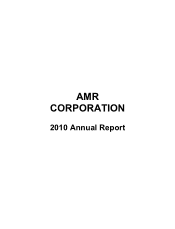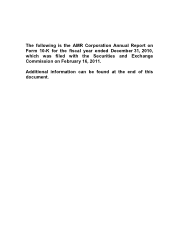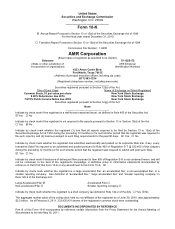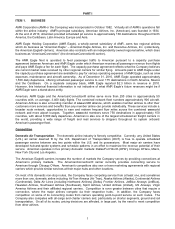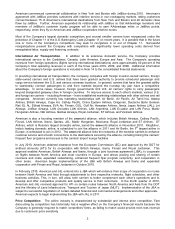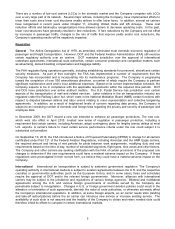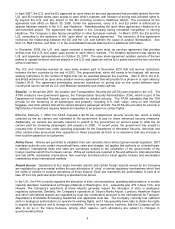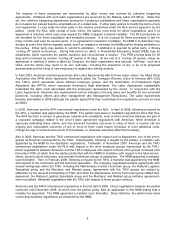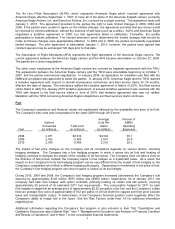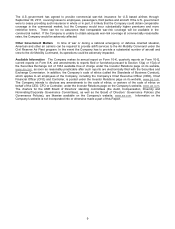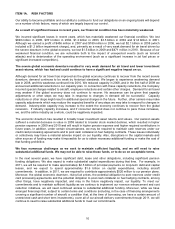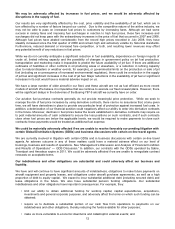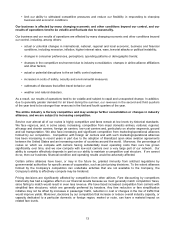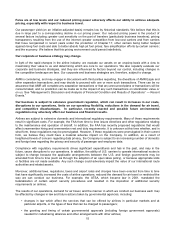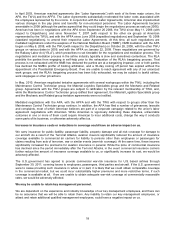American Airlines 2010 Annual Report Download - page 11
Download and view the complete annual report
Please find page 11 of the 2010 American Airlines annual report below. You can navigate through the pages in the report by either clicking on the pages listed below, or by using the keyword search tool below to find specific information within the annual report.
8
Frequent Flyer Program
American established the AAdvantage® frequent flyer program (AAdvantage) to develop passenger loyalty by
offering awards to travelers for their continued patronage. The Company believes that the AAdvantage program is
one of its competitive strengths. AAdvantage benefits from a growing base of approximately 67 million members
with desirable demographics who have demonstrated a strong willingness to collect AAdvantage miles over other
loyalty program incentives and are generally disposed to adjusting their purchasing behavior in order to earn
additional AAdvantage miles. AAdvantage members earn mileage credits by flying on American, American Eagle,
and the AmericanConnection® carrier or by using services of other participants in the AAdvantage program.
Mileage credits can be redeemed for free, discounted or upgraded travel on American, American Eagle or other
participating airlines, or for other awards. Once a member accrues sufficient mileage for an award, the member
may book award travel. Most travel awards are subject to capacity controlled seating. A member’s mileage credit
does not expire as long as that member has any type of qualifying activity at least once every 18 months.
American sells mileage credits and related services to other participants in the AAdvantage program. There are
over 1,000 program participants, including a leading credit card issuer, hotels, car rental companies and other
products and services companies in the AAdvantage program. The Company believes that program participants
benefit from the sustained purchasing behavior of AAdvantage members, which translates into a recurring stream
of revenues for AAdvantage. Under its agreements with AAdvantage members and program participants, the
Company reserves the right to change the AAdvantage program at any time without notice, and may end the
program with six months notice. As of December 31, 2010, AAdvantage had approximately 67 million total
members, and 587 billion outstanding award miles. During 2010, AAdvantage issued approximately 185 billion
miles, of which approximately 62% were sold to program participants. See “Critical Accounting Policies and
Estimates” under Item 7 for more information on AAdvantage.
Cargo
American Airlines Cargo, a division of American Airlines, Inc., provides over 90 million pounds of weekly cargo lift
capacity to major cities in the United States, Europe, Canada, Mexico, the Caribbean, Latin America and Asia.
American’s cargo network is one of the largest air cargo networks in the world, with facilities and interline
connections available across the globe. During 2010, American Airlines Cargo accounted for approximately 3.0%
of the Company’s operating revenues by generating $672 million in freight and mail revenue, an increase of
16.3% versus 2009.
Other revenues
Other revenues, which approximate 10.8% of total revenues, includes revenue from the marketing services
related to the sale of mileage credits in the AAdvantage program as discussed above, membership fees and
related revenue from the Company’s Admirals Club operations, and other miscellaneous service revenue,
including administrative service charges and baggage handling fees. Other revenues have been increasing as
the Company unbundles its services and charges for ancillary services.
Other Matters
Seasonality and Other Factors The Company’s results of operations for any interim period are not necessarily
indicative of those for the entire year since the air transportation business is subject to seasonal fluctuations.
Higher demand for air travel has traditionally resulted in more favorable operating and financial results for the
second and third quarters of the year than for the first and fourth quarters. Fears of terrorism or war, fare
initiatives, fluctuations in fuel prices, labor actions, weather, natural disasters, outbreaks of disease, and other
factors could impact this seasonal pattern. Unaudited quarterly financial data for the two-year period ended
December 31, 2010 is included in Note 15 to the consolidated financial statements. In addition, the results of
operations in the air transportation business have also significantly fluctuated in the past in response to general
economic conditions.
Insurance The Company carries insurance for public liability, passenger liability, property damage and all-risk
coverage for damage to its aircraft. As a result of the terrorist attacks of September 11, 2001 (the Terrorist
Attacks), aviation insurers significantly reduced the amount of insurance coverage available to commercial air
carriers for liability to persons other than employees or passengers for claims resulting from acts of terrorism, war
or similar events (war-risk coverage). At the same time, these insurers significantly increased the premiums for
aviation insurance in general. While the price of commercial insurance has declined since the period immediately
after the Terrorist Attacks, in the event commercial insurance carriers further reduce the amount of insurance
coverage available to the Company, or significantly increase its cost, the Company would be adversely affected.

